The Samsung Galaxy S6 and S6 edge Review
by Joshua Ho on April 17, 2015 9:00 AM EST- Posted in
- Smartphones
- Samsung
- Mobile
- Galaxy S6
- Galaxy S6 Edge
System Performance Cont'd: GPU Performance
As previously mentioned, the Galaxy S6 uses a Mali T760MP8 clocked at 772 MHz, which should provide a healthy improvement in GPU performance over the Exynos 5433. To test this, we run through our standard suite of game-style GPU benchmarks. However, there are still some CPU benchmarks present within these tests such as the 3DMark physics test. In general though, a strong GPU is needed to perform well in these tests. For those interested in an architectural deep-dive of the Mali T760, I would refer to Ryan’s article on the Midgard architecture for more information.
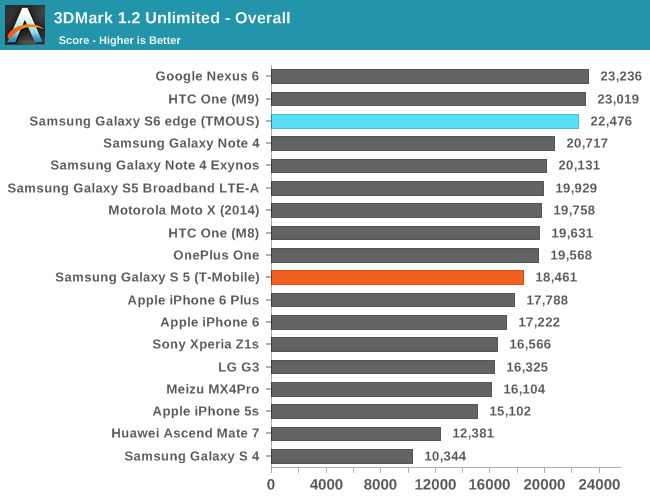
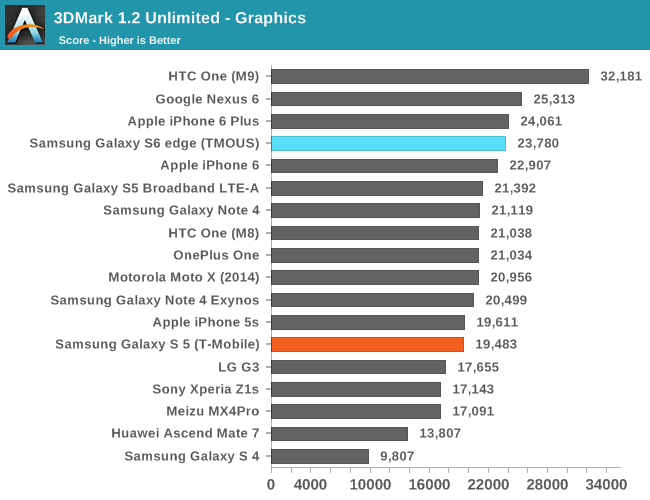
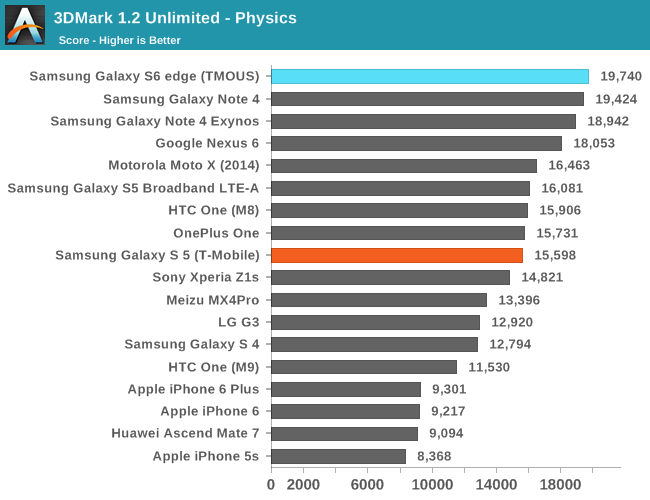
The Galaxy S6 starts out fairly strong in 3DMark. Overall performance is boosted by a chart-topping physics score, while pure graphics performance trails a bit. In this case the S6 is roughly on par with the iPhone 6 Plus, but would have to close quite a gap to catch up to the HTC One (M9).
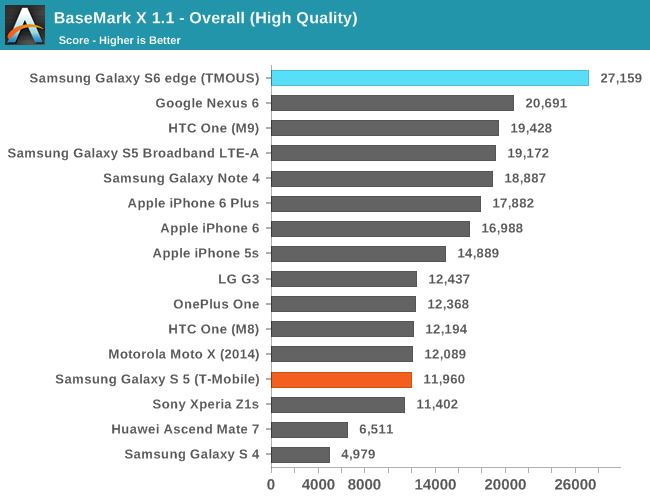
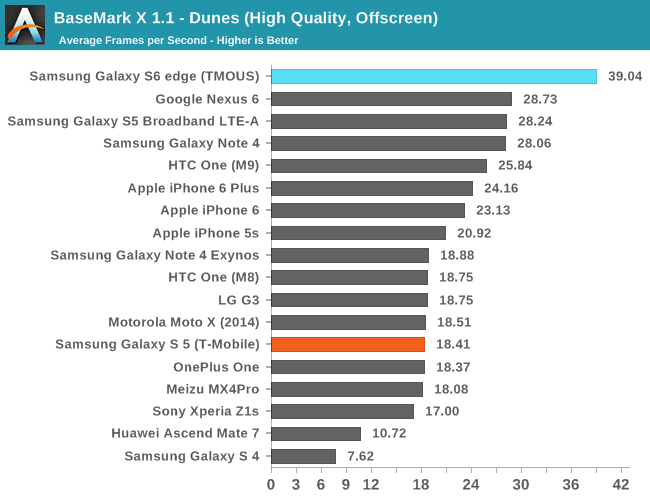
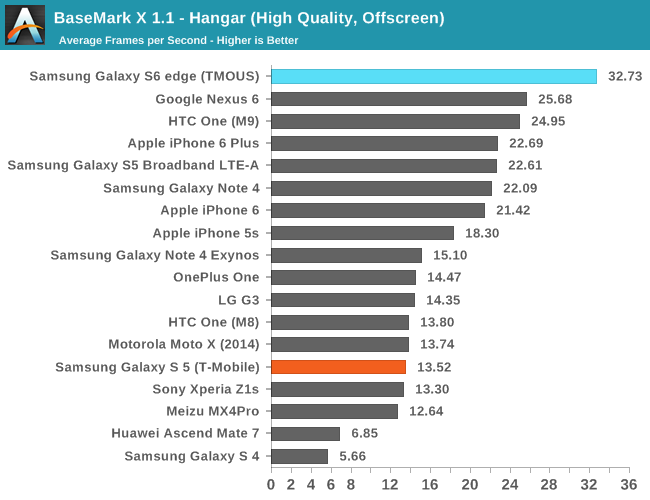
BaseMark X finds the S6 the runaway winner. The phone is well ahead in both the Dunes and Hangar test, beating the next-best phones (primarily Adreno 420/430 based) by 25% or more depending on the test. The increase over the S5 is especially remarkable; Samsung has more than doubled their performance in this benchmark in barely a year.
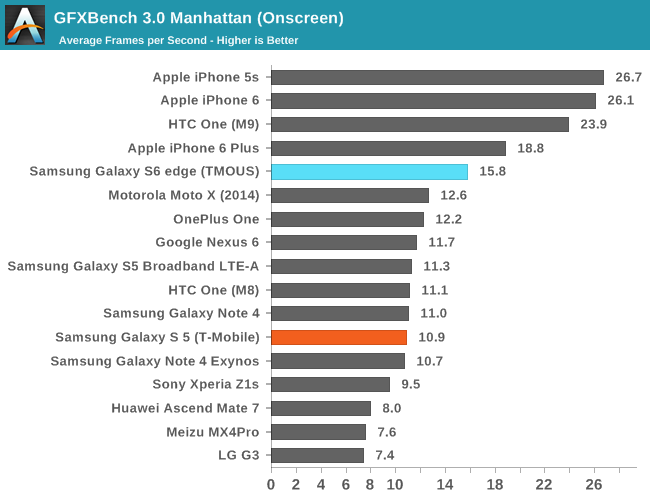
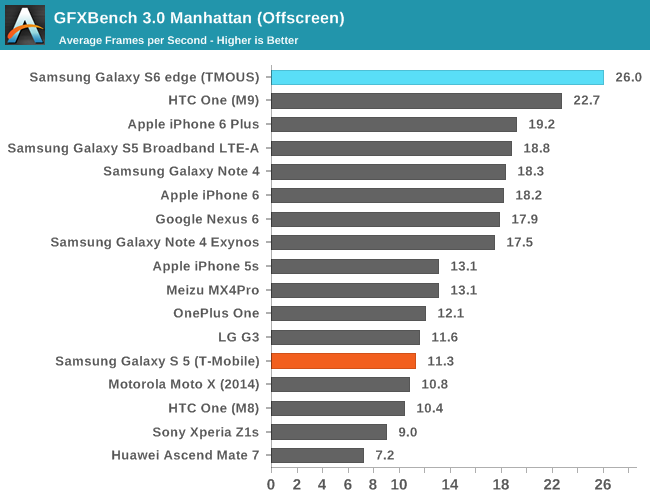
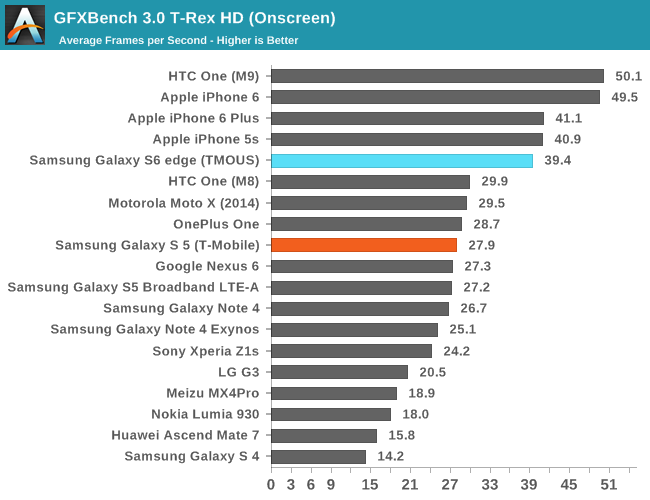
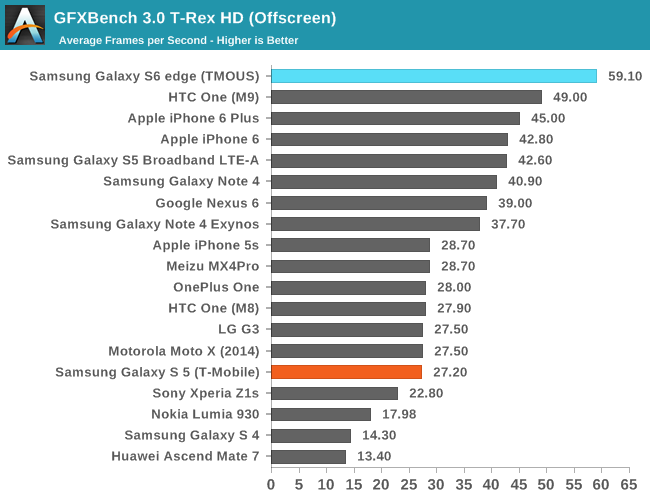
GFXBench 3.0 is another strong showing for the S6. In both offscreen tests it's 15% or more ahead of the next closest phone, which is once again the HTC One (M9). Meanwhile compared once more to the S5, Samsung's performance has more than doubled. Consequently even the onscreen tests show significant gains, as the GPU performance gain more than outstrips the additional performance required to drive the higher resolution 1440p AMOLED display of the S6.
Overall, as we can see the performance of the S6 is in line for what is expected from its Mali T760MP8 configuration. Interestingly though the phone's performance exceeds the scaling we'd expect from adding two shader cores and increasing frequency to 772 MHz, as compared to the Exynos 5433-powered Note 4 Exynos. This suggests that the Exynos 5433's GPU was bandwidth-limited to some extent, in addition to any possible thermal throttling that would occur over the course of a GFXBench run. But I suspect we'll have to save the deep dive for a future article as I can't take the review unit apart to find out.










306 Comments
View All Comments
stbutt - Sunday, April 19, 2015 - link
Wow. What an amazing review that was. I am astonished at how in depth and impartial it is. Congratulations to Mr Joshua Ho and ANANDTECH.watersb - Monday, April 20, 2015 - link
Excellent detail. No way to exhaustively evaluate this decice in a single review, but this is the best I've seen. I read every word. Thanks!jasonjason - Monday, April 20, 2015 - link
s6 edge is not in-cellUser.Name - Monday, April 20, 2015 - link
Am I the only person that holds onto a smart phone for more than 18-24 months?I really dislike the trend of smart phones becoming more and more "disposable" items.
For my own requirements, they're honestly at the point now that they're fast enough, the screens are good enough, and I don't use the camera enough (I carry around a Sony NEX) that I could buy any of the high-end phones like this or an iPhone 6 and stick with it for the next five years. Storage is the only thing which I am constantly limited by.
Yes, you now have the option of a 128GB phone - well my music library alone is more than a terabyte in size. Now I don't *need* to carry my entire music library on my person at all times, but it would be nice if I could.
When you consider that a phone is also storing apps, games, photos, videos and other data, even 128GB is not a lot of storage. I may only have 30GB or so left over that I can dedicate to music after all that - which means that I'm better off still carrying around an old 160GB iPod. What I want more than anything is a phone which can finally replace that.
With a MicroSD slot, you can dedicate all of that storage to media. 64GB MicroSDXC cards are dirt-cheap right now, 128GB are a bit more expensive, and they currently top out at 200GB.
Well several years from now there may be 256GB, 384GB and 512GB cards available at the same prices 64/128/200GB cards are today.
The SDXC standard supports up to 2TB, so theoretically you could have that much storage in any phone with a MicroSDXC slot if such a card were ever released.
It just seems short-sighted to remove the MicroSD slot.
sevin7 - Monday, April 20, 2015 - link
Your battery will likely need replacing before 5 years... having to ship you're phone off for a replacement battery is just as bad as the storage problemUser.Name - Wednesday, April 22, 2015 - link
I actually mentioned a replaceable battery in my initial draft, intending to shuffle it to the end of the post, but I must have removed it instead.I completely agree, a replaceable standard battery is an important thing to have.
While I have done it, I don't want to have to disassemble a phone to replace the battery, and swap it out with a third-party one of questionable quality/safety standards.
Gorgenapper - Wednesday, April 22, 2015 - link
Micro SD cards are not as reliable as the internal flash memory (and obviously not as fast). I experienced this first hand when I went on vacation last summer and used my Samsung GS4 Active to take pics and videos. On the second night, I powered the phone off and swapped the batteries, and found that all the pics / videos I took for that day were gone, even though they had been showing in QuickPic when I got back to the hotel before powering the phone off.The micro SD card (Sandisk UHS-10 64gb) had gone into failsafe read-only mode due to failure. I had to connect to the WiFi every night and back my stuff up to Google Drive.
User.Name - Wednesday, April 22, 2015 - link
Perhaps I have been fortunate, but as long as I have paid for quality cards and checked that they are genuine (there are a lot of fake SanDisk cards out there) I have yet to have one fail on me. And moving to a read-only state is a pretty good failure mode if you ask me.But I don't think that MicroSD should *replace* the internal storage. That's why I want a phone with 128GB—or more—internal storage in addition to a MicroSD slot, so that the MicroSD is only used to store media.
I just want the option of having my phone replace the need for carrying around an old iPod. I don't plan on using MicroSD for running apps, or making up for the fact that the phone itself only has 8GB of storage.
der - Tuesday, April 21, 2015 - link
I missed this review. Are you KIDDING ME Anandtech!sonicmerlin - Tuesday, April 21, 2015 - link
You failed to mention there's a maddening delay when you use Samsung's replacement for "Ok, Google" voice activation features. They disabled the standard Google activation and replaced it with their inferior version.